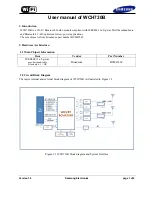
In most situations, the router provides DHCP services, and you can
leave this option disabled. However, if for any reason the router
does not provide DHCP services, enable this option. The AP's DHCP
Server will then manage the IP addresses and other network
configuration information for wireless clients associated with the
AP.
The computers (and other devices) connected to your LAN also
need to have their TCP/IP configuration set to "DHCP" or "Obtain
an IP address automatically".
When you set Enable DHCP Server, the following options are
displayed.
DHCP IP Address Range
These two IP values (from and to) define a range of IP addresses
that the DHCP Server uses when assigning addresses to
computers and devices on your Local Area Network. Any addresses
that are outside of this range are not managed by the DHCP Server;
these could, therefore, be used for manually configured devices or
devices that cannot use DHCP to obtain network address details
automatically.
It is possible for a computer or device that is manually configured
to have an address that does reside within this range. In this case
the address should be reserved (see
below), so
that the DHCP Server knows that this specific address can only be
used by a specific computer or device.
Your Access Point, by default, has a static IP address of
192.168.1.1. This means that addresses 192.168.1.2 to
192.168.1.254 can be made available for allocation by the DHCP
Server.
Example:
Your Access Point uses 192.168.1.1 for the IP address. You've
assigned a computer that you want to designate as a Web server
with a static IP address of 192.168.1.3. You've assigned another
computer that you want to designate as an FTP server with a static
IP address of 192.168.1.4. Therefore the starting IP address for
your DHCP IP address range needs to be 192.168.1.5 or greater.
Example:
Suppose you configure the DHCP Server to manage addresses
From 192.168.1.100 To 192.168.1.199. This means that
192.168.1.3 to 192.168.1.99 and 192.168.1.200 to
192.168.1.254 are NOT managed by the DHCP Server. Computers
or devices that use addresses from these ranges are to be
26
















































